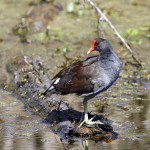• • •
Common Moorhens forage in freshwater marshes, ponds and lazy rivers, walking and swimming in aquatic vegetation, picking at seeds, snails, grasses and aquatic insects. They are similar to the American Coot, but have a distinctive red bill with a yellow tip during breeding season.
• Length: 14 inches
• Wingspan: 21 inches
• Season: Year-round
More about Common Moorhens.
Where they are, and when.
They are very chatty and some of their calls sound like a clucking chicken.
Common Moorhen sometimes have unusual family arrangements, with two females sharing a nest and a male partner. During mating season they may have two or three broods, and sometimes one Moorhen may raise another’s chicks. They hide their bowl-shaped nests, built with cattail stems and marsh grasses, in dense wetland vegetation.
October 9, 2010
Common Moorhen are thick along the edges of the canals at Brazos Bend State Park, stepping through the vegetation, swimming short distances, climbing up on fallen limbs and chattering the whole time. They are often in the company of coots, ducks and other waterfowl. Along with Coots and White Ibises, they are birds you can count on seeing in the park almost any time of the year.





